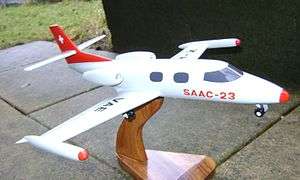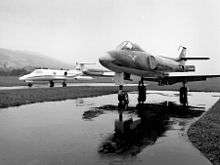SAAC-23
| SAAC-23 | |
|---|---|
 | |
| Role | Business jet |
| National origin | Switzerland & United States |
| Designer | Flug- und Fahrzeugwerke AG& Learjet based on a design by Dr.eng. Hans-Luzius Studer |
| Number built | 0 |
| Variants | Learjet 23 |
The SAAC-23 was a project study for a Business jet in the early 1960s in Switzerland.
History
Flug- und Fahrzeugwerke AG (FFA) developed the FFA P-16 combat aircraft for the Swiss Air Force. The Swiss government canceled the purchase of 100 P-16s after the second crash of a pre-production aircraft. The Flug- und Fahrzeugwerke AG tried to find also export customers for the P-16. For the USA the version AJ-7 with modified, shortened engine exhaust and a fin under the tail as well as the after-burning General Electric J79-11A was projected. Because of this project the son of William P. Lear tested the P-16 in Switzerland. Already in the 1950s, William P.Bill Lear had developed the LearStar, his first business travel aircraft. He equipped Lockheed Model 18 Lodestars with new systems and interior arrangement for eight to twelve passengers. After selling LearStar's license rights, Lear began to develop a small Business jet around 1960. As his son Bill Lear pointed out the good flying characteristics of the P-16, in particular on the wing layout, which allowed short take-offs and landings.
As part of the project, Lear founded the parent company Swiss American Aviation Corp. in Delaware in April 1960. (SAAC) with a subsidiary Aviation Development Corp. in St. Gallen. Later, this changed to Wichita, Kansas USA and Geneva, Switzerland. In Switzerland, the design was revised with the support of Gordon Israel, who had already worked as a designer of the Grumman F7F Tigercat and the Grumman F9F Panther before joining Lear to develop the LearStar. Further development work in Switzerland was provided by Hans-Luzius Studer, who had designed the FFA P-16 combat aircraft of the Flug- und Fahrzeugwerke Altenrhein, from which was largely taken over the wing design for the new aircraft. The project was named SAAC-23.
The SAAC-23 should be a business jet in low-winglayout and crosstail layout with two jet engines at the stern, wingtip tanks, landing gear with two wheels on each undercarriage and two windows on each fuselage side for the passenger area. The tail / Side rudder and elevator and landing gear should be based directly on the components of the P-16.
It was planned to manufacture side rudder and elevator, wings, wing end tanks and the landing gear at FFA and the fuselage, engines and so one in the USA. There should be two assembly lines, one in the USA and one in Switzerland. What is normal today, that aircraft assemblies are produced on different continents and then shipped to various assembly lines, was a novelty at the time. With the landing gear coming directly from the P-16, the SAAC-23 would, in contrast to the Learjet 23, be capable of field operations. William Lear did not agree with the provisions of the Swiss Confederation regarding labour and production regulations and considered the administrative procedures too cumbersome. Thus, the idea of two assembly lines was discarded and the aircraft construction revised.
Specifications

- Speed = 850 km/h
- Range = 3000 km
- Seats = Max. 9
- Needet Runway for Take-off = 1000 m
- Weight = 5600 kg
Successor project Learjet 23
The aircraft received the designation Learjet 23 after the constructive overhaul and the reorganized production planning, where the LearJet Corporation clearly had the lead and the Flug- und Fahrzeugwerke Altenrhein only acted as a subcontractor. FFA was supposed to build the prototypes, but not the serial production, because of the commissioning of the Mirage III production for the Swiss Air Force. In 1962, the costs for serial production had risen to such an extent that Lear withdrew from the concept of an international production and provided for a sole production in the USA. He founded the Lear Jet Corp. in Wichita. And began the production of prototypes with parts already produced in Switzerland. Before the start of the prototypes, some modifications were made. For example, the rear fuselage was extended by 51 cm and the engines were moved backwards by the same amount. The rudder surfaces were also enlarged as compared to the initial design.
The first flight of the Lear Jet 23 (the name was only later called Learjet) of this revolutionary type took place on October 7, 1963 in Wichita and took 30-minute . A second prototype took flight test on March 5, 1964. The Federal Aviation Administration (FAA) approval effort was a setback when, on June 4, 1964, the first prototype had to carry out a belly landing on its 167th flight and then burned out. The two pilots survived the crash. On 31 July 1964 the FAA approval was confirmed. The number "23" in the type designation was chosen because the design should comply with the provisions of the Federal Aviation Regulations (FAR) Part 23, issued by the FAA. These gave a weight limit of 12,500 lb. .[1]
It was then still planned that the FFA to the distribution and do the maintenance of the Learjet 23 in Europe. Therefore, the Learjet 23 with the registrations N803LJ and N706L were exhibited together with the FFA P-16 X-HB-VAC and X-HB-VAD on St. Gallen–Altenrhein Airport. However, this idea was not followed up and the collaboration between FFA and Lear Jet Corporation finally ended.
References
- ↑ Fricker, John (March 1991). "Switzerland's P-16 – Father of the Learjet". AIR International: 139–146.
Further reading
- "One thousand Learjets … and a Longhorn or two!". AIR International: 215. May 1980.
- Taylor, John W.R., ed. (1966). Jane's all the World's Aircraft 1965-66. London: Sampson Low, Marston & Company, Ltd.
- Urech, Jakob (1974). Die Flugzeuge der schweizerischen Fliegertruppe seit 1914 (in German). Stäfa Verlag Th Gut & Co.
- Bridel, Georges (1975). Schweizerische Strahlflugzeuge und Strahltrieb werke. (in German). Luzern: Verlag Verkehrshaus der Schweiz. ISBN 3-85954-902-2.
- Strehler, Hanspeter (2004). Der Schweizer P-16 (in German). Emmenbrücke: H. Strehler. ISBN 3-033-00051-7.
- Schürmann, Roman (2009). Helvetische Jäger : Dramen und Skandale am Militärhimmel (in German) (1. Aufl. ed.). Zürich: Rotpunktverlag. ISBN 978-3-85869-406-5.
- Luc Leonardi: P-16, prototypes suisses d'avions à réaction, N-20, Lear Jet, Piranha. Editions Secavia, Genève, 2011, ISBN 2-88268-015-5. (French)
- William Green, Gerald Pollinger: Die Flugzeuge der Welt. Werner Classen Verlag, Zürich und Stuttgart 1960.
External links
| Wikimedia Commons has media related to SAAC-23. |
- External picture of the SAAC-23-project
- zwei P-16 und zwei LJ-23
- The Lear Jet 23/24/25/28/29 (airliners.net; englisch)
- Archived [Date missing], at www.luftfahrt.ch Error: unknown archive URL Interessen-Gemeinschaft Luftfahrt.
- Jagdbomben- und Erdkampfflugzeug FFA P-16. Private Aircraftarchiv